Ford Theatre, spelled Ford Theater for the original radio version and known, in full, as The Ford Television Theatre for the TV version, is a radio and television anthology series broadcast in the United States in the 1940s and 1950s. At various times the television series appeared on all three major television networks, while the radio version was broadcast on two separate networks and on two separate coasts. Ford Theatre was named for its sponsor, the Ford Motor Company, which had an earlier success with its concert music series, The Ford Sunday Evening Hour (1934–42).
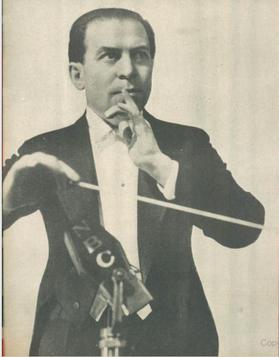
Phil Spitalny was a Russian Empire-born American musician, music critic, composer, and bandleader heard often on radio during the 1930s and 1940s. He rose to fame after he led an all-female orchestra, a novelty at the time.
The American Album of Familiar Music is a radio program of popular music broadcast from October 11, 1931, to June 20, 1954, first on NBC, then on ABC and then on local stations. Directed by James Haupt, the show was produced by Frank and Anne Hummert, better remembered today for creating Ma Perkins and numerous other soap operas.

The Danny Kaye Show was an American variety show, hosted by the stage and screen star Danny Kaye, which aired on Wednesday nights from September 25, 1963, to June 7, 1967, on the CBS television network. Directed by Robert Scheerer, it premiered in black-and-white. It switched to color broadcasts in the fall of 1965. At the time, Kaye was at the height of his popularity. He starred in a string of successful 1940s and 1950s musical comedy features, made numerous personal appearances at venues such as the London Palladium, and his rare selective visits to the small screen were considered major events. With his recent motion pictures considered disappointments, three triumphant early 1960s television specials led the way to this series. Prior to his film and television career, Kaye had made a name for himself with his own radio show, also titled The Danny Kaye Show. He made numerous guest appearances on other comedy and variety radio shows and headlined in several major Broadway musical revues throughout the 1940s.

When Johnny Comes Marching Home is a 1942 musical film directed by Charles Lamont and starring Allan Jones and Jane Frazee. The film is loosely based on the song with the same title.
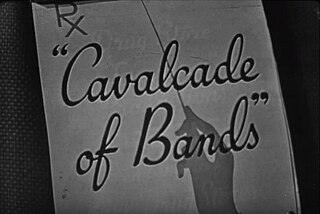
Cavalcade of Bands is an early 1950s American television series which aired on the now defunct DuMont Television Network.
The Saint was a radio adventure program in the United States that featured a character created by author Leslie Charteris. As the program's introduction said, The Saint, was "known to millions from books, magazines, and motion pictures." Several versions of the program appeared on different networks.
The MGM Theater of the Air is a one-hour radio dramatic anthology in the United States. It was broadcast on WMGM in New York City and syndicated to other stations via electrical transcription October 14, 1949 – December 7, 1951. It was carried on Mutual January 5-December 27, 1952.

The Frank Sinatra Show was a title applied—in some cases specifically and in other cases generically—to several radio musical programs in the United States, some of which had other distinct titles as indicated below. Singer Frank Sinatra starred in the programs, some of which were broadcast on CBS, while others were on NBC.
The Danny Kaye Show is an American old-time radio comedy-variety program. Broadcast on the CBS radio network, it ran from January 6, 1945 to May 31, 1946.
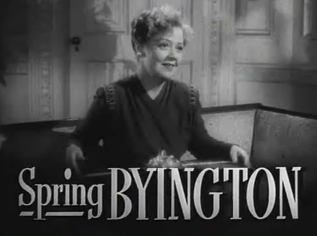
December Bride is an American old-time radio situation comedy. It was broadcast on CBS from June 8, 1952, to September 6, 1953, replacing Jack Benny's program. CBS television broadcast a version of the program 1954–1959.
The Electric Hour is an American old-time radio program of popular music. It was broadcast on CBS from September 20, 1944, to June 9, 1946.

The Gay Nineties Revue is an American old-time radio musical variety program. It was broadcast on CBS from July 2, 1939, to November 13, 1944. ABC broadcast a television version of the program in 1948–1949.
The Greatest Story Ever Told is an American old-time radio religious drama. It was broadcast on ABC from January 26, 1947, until December 30, 1956. Beginning July 25, 1948, the program was also broadcast via shortwave radio to 58 other countries by the World Wide Broadcasting Foundation.
Hallmark Playhouse is an American old-time radio dramatic anthology series. It was broadcast on CBS from June 10, 1948 until February 1, 1953, and was described by one author as "a program that consistently produced the highest levels of production quality and value." Beginning on February 8, 1953, the program underwent changes of title, host, and format. It was broadcast as The Hallmark Hall of Fame until March 27, 1955, still on CBS.
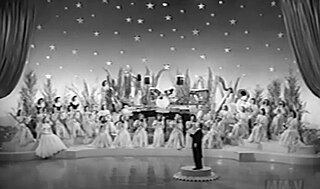
The Hour of Charm Orchestra was an American musical group led by Phil Spitalny. Popular in the 1930s and 1940s, it was an all-female orchestra in an era when most orchestra members were male. The group was also known as Phil Spitalny's All-Girl Orchestra.
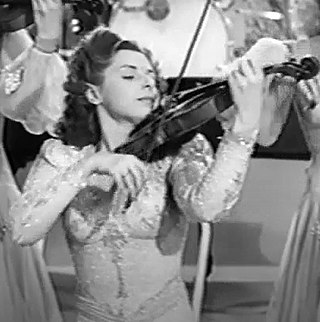
Evelyn Kaye Klein (1911–1990) was an American violinist, best known for her performances as "Evelyn and Her Magic Violin" with Phil Spitalny's Hour of Charm Orchestra.
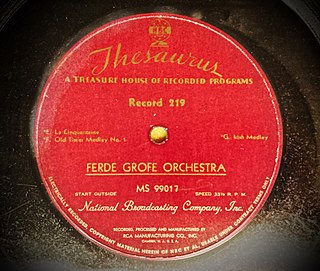
Thesaurus was an American syndication service that provided transcribed programs for use by radio stations.

Kay Kyser's Kollege of Musical Knowledge is an American old-time radio musical quiz program starring Kay Kyser. It was broadcast on Mutual, NBC, and ABC beginning on February 1, 1938, and ending on July 29, 1949.

Margherita Maria Francesca LaCentra was an American contralto singer, best known for her work on old-time radio and her singing with Artie Shaw's orchestra. She also performed as Barbara Fulton.












